Atlanta, Georgia Blood Testing Facilities
 Represents a LabCorp blood testing facility
Represents a LabCorp blood testing facility Represents a Quest Diagnostics blood testing facility
Represents a Quest Diagnostics blood testing facility

Nearby Labcorp Blood Testing facilities:
- Labcorp Center Distance: 1 m, 315 Blvd Ne Suite 532, Atlanta, Fulton County, GA, 30312
- Labcorp Center Distance: 6 m, 2712 N Decatur Rd, Decatur, Dekalb County, GA, 30033
- Labcorp Center Distance: 9 m, 1462 W. Montreal Rd Ste 114, Tucker, Dekalb County, GA, 30084
- Labcorp Center Distance: 10 m, 975 Johnson Ferry Rd Ne 320, Atlanta, Fulton County, GA, 30342
- Labcorp Center Distance: 11 m, 5667 Peachtree Dunwoody Rd 295, Atlanta, Fulton County, GA, 30342
- Labcorp Center Distance: 12 m, 755 Mount Vernon Hwy Ne Ste 270, Atlanta, Fulton County, GA, 30328
- Labcorp Center Distance: 14 m, 1676 Mulkey Rd Suite 100, Austell, Cobb County, GA, 30106
- Labcorp Center Distance: 17 m, 790 Church St 505, Marietta, Cobb County, GA, 30060
- Labcorp Center Distance: 19 m, 1129 Hospital Dr Ste 5E, Stockbridge, Henry County, GA, 30281
- Labcorp Center Distance: 21 m, 3800 Pleasant Hill Rd Ste 1, Duluth, Gwinnett County, GA, 30096
- Labcorp Center Distance: 22 m, 1288 Wellbrook Cir Ne Ste C, Conyers, Rockdale County, GA, 30012
- Labcorp Center Distance: 23 m, 1800 Tree Lane Suite 310, Snellville, Gwinnett County, GA, 30078
- Labcorp Center Distance: 25 m, 4275 Johns Creek Pkwy Ste B, Suwanee, Forsyth County, GA, 30024
- Labcorp Center Distance: 26 m, 575 Professional Dr Ste 280, Lawrenceville, Gwinnett County, GA, 30045
- Labcorp Center Distance: 30 m, 690 Dallas Hwy Suite 210, Villa Rica, Carroll County, GA, 30180
- Labcorp Center Distance: 33 m, 1660 Market Place Blvd, Cumming, Forsyth County, GA, 30041
- Labcorp Center Distance: 36 m, 619 S 8Th Street Suite 102, Griffin, Spalding County, GA, 30224
- Labcorp Center Distance: 37 m, 2151 W. Spring St, Monroe, Walton County, GA, 30655
- Labcorp Center Distance: 41 m, 812 S. Park St Suite 6, Carrollton, Carroll County, GA, 30117
- Labcorp Center Distance: 51 m, 2350 Limestone Pkwy, Gainesville, Hall County, GA, 30501
- Labcorp Center Distance: 56 m, 88 Martin Luther King Drive, Forsyth, Monroe County, GA, 31029
- Labcorp Center Distance: 57 m, 311 W 8Th St Ne, Rome, Floyd County, GA, 30165
- Labcorp Center Distance: 58 m, 1000 Hawthorne Ave Ste D, Athens, Clarke County, GA, 30606
- Labcorp Center Distance: 59 m, 801 West Gordon Street, Thomaston, Upson County, GA, 30286
- Labcorp Center Distance: 60 m, 100 Hospital Court, Calhoun, Gordon County, GA, 30701
- Labcorp Center Distance: 61 m, 70 Medical Dr, Commerce, Jackson County, GA, 30529
- Labcorp Center Distance: 63 m, 1600 Vernon Rd Suite D, Lagrange, Troup County, GA, 30240
- Labcorp Center Distance: 69 m, 101 Lake Oconee Park, Eatonton, Greene County, GA, 31024
- Labcorp Center Distance: 70 m, 113 Arkwright Landing Suite B, Macon, Bibb County, GA, 31210
- Labcorp Center Distance: 78 m, 51 Overview Drive, Blue Ridge, Fannin County, GA, 30513
- Labcorp Center Distance: 82 m, 1412 Leighton Ave, Anniston, Calhoun County, AL, 36207
- Labcorp Center Distance: 90 m, 110 Main Street, Hiawassee, Towns County, GA, 30546
- Labcorp Center Distance: 94 m, 120 Gordon St, Washington, Wilkes County, GA, 30673
- Labcorp Center Distance: 96 m, 217 Wes Park Drive, Perry, Houston County, GA, 31069
- Labcorp Center Distance: 98 m, 1518-B Professional Pkwy, Auburn, Lee County, AL, 36830
Nearby Quest Blood Testing facilities:
- Quest Center Distance: 1 m, 550 Peachtree St Ne, Atlanta, Fulton County, GA, 30308-2264
- Quest Center Distance: 5 m, 1136 Cleveland Ave Ste 303, East Point, Fulton County, GA, 30344-3618
- Quest Center Distance: 11 m, 5673 Peachtree Dunwoody Rd Ne, Atlanta, Fulton County, GA, 30342-1701
- Quest Center Distance: 14 m, 3825 Medical Park Dr., Austell, Cobb County, GA, 30106-6831
- Quest Center Distance: 17 m, 790 Church St Nw, Marietta, Cobb County, GA, 30060-8950
- Quest Center Distance: 18 m, 1365 Rock Quarry Rd Ste 203, Stockbridge, Henry County, GA, 30281-5023
- Quest Center Distance: 19 m, 6025 Professional Pkwy, Douglasville, Douglas County, GA, 30134-5610
- Quest Center Distance: 23 m, 1630 Scenic Hwy. N, Snellville, Gwinnett County, GA, 30078-5685
- Quest Center Distance: 26 m, 575 Professional Drive Ste 200, Lawrenceville, Gwinnett County, GA, 30045-3300
- Quest Center Distance: 33 m, 1634 Market Place Blvd, Cumming, Forsyth County, GA, 30041-7927
- Quest Center Distance: 35 m, 120B West College Street, Griffin, Spalding County, GA, 30224-4238
- Quest Center Distance: 58 m, 1000 Hawthorne Ave Ste Q, Athens, Clarke County, GA, 30606-2168
- Quest Center Distance: 70 m, 4100 Riverside Dr, Macon, Bibb County, GA, 31210-1852
- Quest Center Distance: 82 m, 901 Leighton Avenue Ste 302, Anniston, Calhoun County, AL, 36207-5703
- Quest Center Distance: 94 m, 1629 10Th Ave Ste B, Columbus, Muscogee County, GA, 31901-3520
Atlanta Hormone Replacement Therapy Services
Hormone Optimization and Restoration may be your ticket to a healthier life. As researchers learn more about aging and diseases associated with aging, it is becoming clear that hormone balance is an incredibly important aspect of health and wellness. Many of the symptoms that men and women associate with aging are actually the result of imbalanced hormone levels which inhibit the body's ability to support and sustain itself optimally, leading to symptoms from weight gain to hypertension to even depression and anxiety.
When you make an appointment, we will arrange for you to meet one of our partnering physicians in your area. Our affiliate will give you a simple physical and take a quick blood sample, and that's all we need to have a vivid snapshot of your hormone state. Your doctor will send your blood sample to LabCorp, one of the largest and most renowned diagnostic facilities in the United States. They will run a full diagnostic analysis known as a Comprehensive Hormone Panel, which will provide our licensed and board-certified Hormone Doctors with all the information that they need to determine the best course of action to optimize and restore your hormone levels.
Atlanta HGH Therapy for Growth Hormone Deficiency
One of the primary services that we provide to our patients is Human Growth Hormone Therapy. HGH is one of the body's most important hormones. Most people simply think that it helps children grow, or that it is used for performance enhancement, but in reality, Human Growth Hormone is intimately involved in cellular processes all throughout the human body. HGH is an anabolic hormone that stimulates cellular metabolism. This is why it makes children grow. What most people don't realize is that it remains important far beyond puberty. It is intrinsically important to cardiovascular health, psychological health, and body composition, and it also promotes bone health and healing.
HGH Deficiency is a serious medical condition which can have long term health consequences while also suppressing your overall quality of life. Our clinic offers Bio-Identical HGH Therapy Programs designed to restore your HGH Balance to levels associated with early adulthood in order to boost your vitality and improve your physiological health.
Atlanta Sermorelin Therapy Programs for HGH Deficiency
HGH Injections aren't the only tool available for HGH Deficiency, however. Our clinic also offers a treatment option known as Sermorelin Acetate Therapy, and many doctors find this form of Growth Hormone Restoration superior to Bio-Identical HGH for many patients. Sermorelin stimulates the natural production of Growth Hormone by the pituitary by emulating the function of a naturally occurring hormone known as GH-RH.
Sermorelin Acetate is cheaper than Human Growth Hormone, and, unlike HGH Injections, Sermorelin helps facilitate natural patterns of HGH release in the blood stream. Sermorelin can also be prescribed off-label, which gives your physician the opportunity to prescribe the treatment at his or her own medical discretion.
Atlanta Testosterone Therapy for Low-T and Andropause
The Conscious Evolution Institute also offers Testosterone Therapy for men over the age of thirty that suffer from clinically diagnosed Testosterone Deficiency. With Testosterone Injections, Creams, or Patches, it is possible to effectively restore sexual potency in patients while also providing other major benefits that Erectile Dysfunction medications simply cannot. Andropause is associated with a number of symptoms that severely impact male health.
For example, men with Testosterone Deficiency are more likely to experience hypertension and cardiovascular disease. They are also more likely to be depressed and anxious, as well as overweight and fatigued. Bio-Identical Testosterone Therapy combats the underlying cause of this physical decline, allowing patients to feel better, look better, and perform better in the bedroom.
Atlanta HCG Weight Loss Treatments
HCG Therapy is an effective, physician-mediated weight loss treatment designed for patients that are looking for a modern, scientific method to quickly drop pounds. The treatment is designed for patients that have had trouble dieting in the past, and facilitates weight loss via Hormone Therapy and a restrictive diet. The treatment enhances the ability to lose weight by suppressing hunger and stimulating the body to burn body fat over muscle. With our established protocol, we can help you lose as much as 7 pounds per week!
Atlanta Information
Atlanta is by far the largest city in Georgia, and one of the largest cities in the American Southeast. The sprawling metropolitan area is the 9th largest in the United States, tucked between Miami, Florida and Boston, Massachusetts. Atlanta has gone through a population explosion over the last forty years, and is quickly becoming recognized as the New York City of the South.
The rise of Atlanta was facilitated largely by Delta Airlines, and Atlanta's airport, Hartsfield-Jackson, is the most highly trafficked airport in the entire world. Atlanta is filled with amazing attractions from the Georgia Aquarium to beautiful music venues such as the Tabernacle and the Roxy Theater. Atlanta also has a huge national media presence, the home of television channels such as TBS, TNT, CNN, and Cartoon Network. Atlanta is also the home of Coca Cola, the most popular soft drink on earth.
Atlanta, as a result of its large media presence and metropolitan flair, is rapidly becoming an important city for national and global information technology, and is widely becoming known as the Silicon Peach. The city also has one of the nation's best law schools, Emory University, and it also has a fantastic public research university, Georgia Tech.
Atlanta is a wonderful multicultural city, with a number of distinct districts, including Buckhead, Midtown, and Little 5 Points, which is one of the premier bohemian spots in the Southeast. Atlanta is home to a number of professional sports teams, including the Atlanta Hawks, the Atlanta Falcons, and the Atlanta Braves. The Braves are notable for having the largest fan base by area of any sports team in the United States.
The city has a variety of popular museums and tourist destinations, including the Coca Cola Museum, the Carter Presidential Library, and the Martin Luther King, Jr. National Historic Site. Atlanta is a must-see destination for people that want to experience the 21st century South.
All About Atlanta, Georgia Geographic Area



Atlanta ( /ÉotËnlR¦ntÉo/, stressed /R¦tËnlR¦ntÉo/, locally
/ÉotËnlR¦ntÉo/, stressed /R¦tËnlR¦ntÉo/, locally  /R¦tËnlR¦nÉo/) is the capital of and the most populous city in the U.S. state of Georgia, with a 2010 population of 420,003. Atlanta is the cultural and economic center of the Atlanta metropolitan area, home to 5,268,860 people and the ninth largest metropolitan area in the country. Atlanta is the county seat of Fulton County, and a small portion of the city extends eastward into DeKalb County.
/R¦tËnlR¦nÉo/) is the capital of and the most populous city in the U.S. state of Georgia, with a 2010 population of 420,003. Atlanta is the cultural and economic center of the Atlanta metropolitan area, home to 5,268,860 people and the ninth largest metropolitan area in the country. Atlanta is the county seat of Fulton County, and a small portion of the city extends eastward into DeKalb County.
Atlanta was established in 1847 at the intersection of two railroad lines, and the city rose from the ashes of the Civil War to become a national center of commerce. In the decades following the Civil Rights Movement, during which the city earned a reputation as "too busy to hate" for the progressive views of its citizens and leaders, Atlanta attained international prominence. Atlanta is the primary transportation hub of the Southeastern United States via highway, railroad, and air, with Hartsfield aeJackson Atlanta International Airport being the world's busiest airport since 1998. Atlanta is considered an "alpha(-) world city," and, with a gross domestic product of US$270 billion, Atlanta aos economy ranks 15th among world cities and sixth in the nation. Although Atlanta aos economy is considered diverse, dominant sectors include logistics, professional and business services, media operations, government administration, and higher education. Geographically, Atlanta is marked by rolling hills and dense tree coverage. Revitalization of Atlanta's neighborhoods, initially spurred by the 1996 Olympics, has intensified in the 21st century, altering the city's demographics, politics, and culture.
Prior to the arrival of European settlers in north Georgia, Creek and Cherokee Indians inhabited the area. Standing Peachtree, a Creek village located where Peachtree Creek flows into the Chattahoochee River, was the closest Indian settlement to what is now Atlanta. As part of the systematic removal of Native Americans from northern Georgia from 1802 to 1825, the Creek ceded the area in 1821, and white settlers arrived the following year.
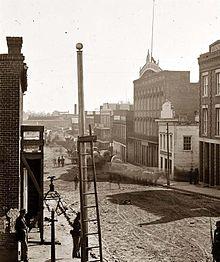
In 1836, the Georgia General Assembly voted to build the Western and Atlantic Railroad in order to provide a link between the port of Savannah and the Midwest. The initial route was to run southward from Chattanooga to a terminus east of the Chattahoochee River, which would then be linked Savannah. After engineers surveyed various possible locations for the terminus, the "zero milepost" was driven into the ground in what is now Five Points. A year later, the area around the milepost had developed into a settlement, first known as auTerminus, au and later as auThrasherville au after a local merchant who built homes and a general store in the area. By 1842, the town had six buildings and 30 residents, and was renamed "Marthasville" to honor the Governor aos daughter. J. Edgar Thomson, Chief Engineer of the Georgia Railroad, suggested the town be renamed "Atlantica-Pacifica, au which was shortened to "Atlanta." The residents approved, and the town was incorporated as Atlanta on December 29, 1847.
By 1860, Atlanta aos population had grown to 9,554. During the Civil War, the nexus of multiple railroads in Atlanta made the city a hub for the distribution of military supplies. In 1864, following the capture of Chattanooga, the Union Army moved southward and began its invasion of north Georgia. The region surrounding Atlanta was the location of several major army battles, culminating with the Battle of Atlanta and a four-month-long siege of the city by the Union Army under the command of General William Tecumseh Sherman. On September 1, 1864, Confederate General John Bell Hood made the decision to retreat from Atlanta, ordering all public buildings and possible assets to the Union Army destroyed. On the next day, Mayor James Calhoun surrendered Atlanta to the Union Army, and on September 7, General Sherman ordered the city aos civilian population to evacuate. On November 11, 1864, in preparation of the Union Army aos march to Savannah, Sherman ordered Atlanta to be burned to the ground, sparing only the city aos churches and hospitals.
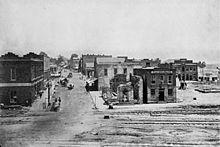
After the Civil War ended in 1865, Atlanta was gradually rebuilt. Due to the city aos superior rail transportation network, the state capital was moved to Atlanta from Milledgeville in 1868. In the 1880 Census, Atlanta surpassed Savannah as Georgia aos largest city. Beginning in the 1880s, Henry W. Grady, the editor of the ad adAtlanta Constitution ao ao newspaper, promoted Atlanta to potential investors as a city of the "New South" that would be based upon a modern economy and less reliant on agriculture. By 1885, the founding of the Georgia School of Technology (now Georgia Tech) and the city aos black colleges had established the city as a center for higher education. In 1895, Atlanta hosted the Cotton States and International Exposition, which attracted nearly 800,000 attendees and successfully promoted the New South aos development to the world.
During the first decades of the twentieth century, Atlanta experienced a period of unprecedented growth. In three decades ao time, Atlanta aos population tripled as the city limits expanded to include nearby streetcar suburbs; the city aos skyline emerged with the construction of the Equitable, Flatiron, Empire, and Candler buildings; and Sweet Auburn emerged as a center of black commerce. However, the period was also marked by strife and tragedy. Increased racial tensions led to the Atlanta Race Riot of 1906, which left at least 27 people dead and over 70 injured. In 1915, Leo Frank, a Jewish-American factory superintendent, was hanged by a lynch mob, drawing attention to antisemitism in the United States. On May 21, 1917, the Great Atlanta Fire destroyed 1,938 buildings in what is now the Old Fourth Ward, resulting in one fatality and the displacement of 10,000 people.
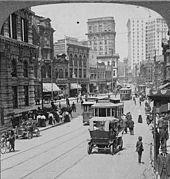
On December 15, 1939, Atlanta hosted the film premiere of Gone with the Wind, the epic film based on the best-selling novel by Atlanta aos Margaret Mitchell. The film's legendary producer, David O. Selznick, as well as the film's stars Clark Gable, Vivien Leigh, and Olivia de Havilland attended the gala event at Loew's Grand Theatre, but Oscar winner Hattie McDaniel, an African American, was barred from the event due to the color of her skin.
Atlanta played a vital role in the Allied effort during World War II due the city aos war-related manufacturing companies, railroad network, and military bases, leading to rapid growth in the city's population and economy. In the 1950s, the city aos newly constructed freeway system allowed middle class Atlantans the ability to relocate to the suburbs. As a result, the city began to make up an ever smaller proportion of the metropolitan area aos population, eventually decreasing from 31% in 1960 to 9% in 2000.
During the 1960s, Atlanta was a major organizing center of the Civil Rights Movement, with Dr. Martin Luther King, Jr., Ralph David Abernathy, and students from Atlanta aos historically black colleges and universities playing major roles in the movement aos leadership. While minimal compared to other cities, Atlanta was not completely free of racial strife. In 1961, the city attempted to thwart blockbusting by erecting road barriers in Cascade Heights, countering the efforts of civic and business leaders to foster Atlanta as the "city too busy to hate". Desegregation of the public sphere came in stages, with public transportation desegregated by 1959, the restaurant at Rich's department store by 1961, movie theaters by 1963, and public schools by 1973.

By 1970, African Americans were a majority of the city aos population and exercised new-found political influence by electing Atlanta aos first black mayor, Maynard Jackson, in 1973. Under Mayor Jackson aos tenure, Atlanta aos airport was modernized, solidifying the city aos role as a transportation center. The opening of the Georgia World Congress Center in 1976 heralded Atlanta aos rise as a convention city. Construction of the city aos subway system began in 1975, with rail service commencing in 1979. However, despite these improvements, Atlanta succumbed to the same decay afflicting major American cities during the era, and the city lost over 100,000 residents between 1970 and 1990, over 20% of its population.
In 1990, Atlanta was selected as the site for the 1996 Summer Olympic Games. Following the announcement, the city government undertook several major construction projects to improve Atlanta aos parks, sporting venues, and transportation infrastructure. While the games themselves were marred by numerous organizational inefficiencies, as well as the Centennial Olympic Park bombing, they were a watershed event in Atlanta aos history, initiating a fundamental transformation of the city in the decade that followed.
During the 2000s, Atlanta underwent a profound transformation demographically, physically, and culturally. Suburbanization, rising prices, a booming economy, and new migrants decreased the city aos black percentage from a high of 67% in 1990 to 54% in 2010. From 2000 to 2010, Atlanta gained 22,763 white residents, 5,142 Asian residents, and 3,095 Hispanic residents, while the city aos black population decreased by 31,678. Much of the city aos demographic change during the decade was driven by young, college-educated professionals: from 2000 to 2009, the three-mile radius surrounding Downtown Atlanta gained 9,722 residents aged 25 to 34 holding at least a four-year degree, an increase of 61%. Between the mid-1990s and 2010, stimulated by funding from the HOPE VI program, Atlanta demolished nearly all of its public housing, a total of 17,000 units and about 10% of all housing units in the city. In 2005, the $2.8 billion BeltLine project was adopted, with the stated goals of converting a disused 22-mile freight railroad loop that surrounds the central city into an art-filled multi-use trail and increasing the city aos park space by 40%. Lastly, Atlanta aos cultural offerings expanded during the 2000s: the High Museum of Art doubled in size; the Alliance Theatre won a Tony Award; and numerous art galleries were established on the once-industrial Westside.
Atlanta encompasses 132.4 square miles (342.9 km2), of which 131.7 square miles (341.1 km2) is land and 0.7 square miles (1.8 km2) is water. The city is situated among the foothills of the Appalachian Mountains, and at 1,050 feet (320 m) above mean sea level, Atlanta has the highest elevation out of major cities east of the Mississippi River. Atlanta straddles the Eastern Continental Divide, such that rainwater that falls on the south and east side of the divide flows into the Atlantic Ocean, while rainwater on the north and west side of the divide flows into the Gulf of Mexico. Atlanta sits atop a ridge south of the Chattahoochee River, which is part of the ACF River Basin. Located at the far northwestern edge of the city, much of the river aos natural habitat is preserved, in part by the Chattahoochee River National Recreation Area.
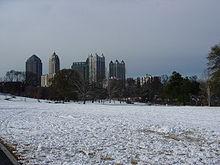
Atlanta's high elevation distinguishes it from most other southern and eastern cities, and contributes to a more temperate climate than is found in cities at similar latitudes. Under the Koppen classification, it has a humid subtropical climate (Cfa), with very warm and humid summers and mild, yet temperamental winters. The warm, maritime air can bring spring-like highs while strong Arctic air masses can push lows into the teens ( o¤ na7 °C). High temperatures in July average 89 °F (32 °C) but occasionally approach 100 °F (38 °C). Temperatures at or above 90 °F (32.2 °C) occur more than 40 days per year. January averages 42.7 °F (5.9 °C), with temperatures in the suburbs slightly cooler. Overnight freezing can be expected 45 nights annually, but high temperatures below 40 °F (4 °C) are very rare. Extremes range from na9 °F ( na23 °C) in February 1899 to 106 °F (41 °C) in June 2012.
Typical of the southeastern U.S., Atlanta receives abundant rainfall that is relatively evenly distributed throughout the year, though spring and early fall are markedly drier. Average annual rainfall is 50.2 inches (1,280 mm). Light dusting of snow is typical with an annual average of 2.5 inches (6.4 cm). The heaviest single storm, known as the auStorm of the Century, au brought around 16 inches (41 cm) of snow in March 1993. However, ice storms usually cause more nuisance than snowfall does, the most severe of such storms occurring on January 7, 1973 and January 9, 2011. Tornados are rare in the city itself, though twisters such as the March 14, 2008 EF2 tornado damaged prominent structures in downtown Atlanta.



Most of Atlanta was burned during the Civil War, depleting the city of a large stock of its historic architecture. Yet architecturally, the city had never been particularly "southern au aebecause Atlanta originated as a railroad town, rather than a patrician southern seaport like Savannah or Charleston, many of the city aos landmarks could have easily been erected in the Northeast or Midwest. In addition, unlike many other Southern cities, such as Richmond and New Orleans, Atlanta chose not to retain its historic architectural characteristics, instead viewing itself as the leading city of a progressive "New South" and opting for expressive modern structures.
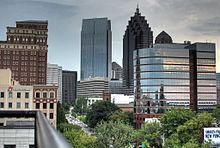
As a result of Atlanta aos embrace of modernism, its cityscape is dominated by relatively recent architectural styles, containing works by most major U.S. firms and some of the more prominent architects of the 20th century. The city aos skyline, which began its marked rise in the 1960s, is punctuated with buildings of both modern and postmodern vintage. At 1,023 feet (312 m), Atlanta aos tallest skyscraper aethe Bank of America Plaza aeis the 52nd-tallest building in the world and the 9th tallest building in the United States. The city aos embrace of modern architecture resulted in an ambivalent approach toward historic preservation, leading to the destruction of notable architectural landmarks, including the Equitable Building (Atlanta aos first skyscraper), Terminal Station, and the Carnegie Library. The Fox Theatre aeAtlanta aos cultural icon aewould have met the same fate had it not been for a grassroots effort to save it in the mid-1970s.
Atlanta is divided into 242 officially defined neighborhoods. The city contains three major high-rise districts, which form a north-south axis along Peachtree: Downtown, Midtown, and Buckhead. Surrounding these high-density districts are leafy, low-density neighborhoods, most of which are dominated by single-family homes.
Downtown Atlanta contains the most office space in the metro area, much of it occupied by government entities. Downtown is also home to the city aos sporting venues and many of its tourist attractions. Midtown Atlanta is the city aos second-largest business district, containing the offices of many of the region aos law firms. Midtown is also known for its art instritutions, cultural attractions, institutions of higher education, and dense form. Buckhead, the city aos uptown district, is eight miles (13 km) north of Downtown and the city aos third-largest business district. The district is marked by an urbanized core along Peachtree Road, surrounded by suburban single-family neighborhoods situated among dense forests and rolling hills.

Surrounding Atlanta aos three high-rise districts are the city's low- and medium-density neighborhoods. The city aos east side is marked by historic streetcar suburbs built from the 1890s-1930s as havens for the upper middle class. These neighborhoods, many of which contain their own villages encircled by shaded, architecturally distinct residential streets, include the Victorian Inman Park, craftsman Kirkwood, Bohemian East Atlanta, and eclectic Old Fourth Ward. On Atlanta aos west side, former warehouses and factories have been converted into housing, retail space, and art galleries, transforming the once-industrial West Midtown into a model neighborhood for smart growth, historic rehabilitation, and infill construction. In southwest Atlanta, neighborhoods closer to downtown originated as streetcar suburbs, including the historic West End, while those farther from downtown retain a postwar suburban layout, including Collier Heights and Cascade Heights, home to much of the city's affluent African American population. Northwest Atlanta, marked by Atlanta aos poorest and most crime-ridden neighborhoods, has been the target of community outreach programs and economic development initiatives.
Gentrification of the city's neighborhoods is one of the more controversial and transformative forces shaping contemporary Atlanta. The gentrification of Atlanta has its origins in the 1970s, after many of Atlanta's neighborhoods had undergone the urban decay that affected other major American cities in the mid-20th century. When neighborhood opposition successfully prevented two freeways from being built through city aos the east side in 1975, the area became the starting point for Atlanta's gentrification. After Atlanta was awarded the Olympic games in 1990, gentrification expanded into other parts of the city, stimulated by infrastructure improvements undertaken in preparation for the games. Gentrification was also aided by the Atlanta Housing Authority's eradication of the city aos public housing. The gentrification of the city aos neighborhoods has been the topic of social commentary, including The Atlanta Way, a documentary detailing the negative effects gentrification has had on the city and its inhabitants.
The 2010 United States Census reported that Atlanta had a population of 420,003. The population density was 3,154 per square mile (1232/km2). The racial makeup and population of Atlanta was 54.0% black or African American, 38.4% white, 3.1% Asian and 0.2% Native American. Those from some other race made up 2.2% of the city aos population, while those from two or more races made up 2.0%. Hispanics of any race made up 5.2% of the city aos population. The median income for a household in the city was $45,171. The per capita income for the city was $ 35,453. 22.6% percent of the population was living below the poverty line. However, compared to the rest of the country, Atlanta's cost of living is 6.00% Lower than the U.S. average. Atlanta has one of the highest LGBT populations per capita, ranking third among major American cities, behind San Francisco and slightly behind Seattle, with 12.8% of the city aos total population recognizing themselves as gay, lesbian, or bisexual.
In the 2010 Census, Atlanta was recorded as the nation aos fourth largest majority black city, and the city has long been known as a center of African American political power, education, and culture, often called a black mecca. However, African American Atlantans have rapidly suburbanized in recent decades, and from 2000 to 2010, the city's black population decreased by 31,678 people, shrinking from 61.4% of the city aos population in 2000 to 54.0% in 2010.
Atlanta has recently undergone a drastic demographic increase in its white population. Between 2000 and 2010, the proportion of whites in the city's population grew faster than that of any other U.S. city. In that decade, Atlanta's white population grew from 31% to 38% of the city aos population, an absolute increase of 22,753 people, more than triple the increase that occurred between 1990 and 2000.
Out of the total population five years and older, 83.3% spoke only English at home, while 8.8% spoke Spanish, 3.9% another Indo-European language and 2.8% an Asian language. Atlanta aos dialect has traditionally been a variation of Southern American English. The Chattahoochee River long formed a border between the Coastal Southern and Southern Appalachian dialects. However, by 2003, ad adAtlanta ao ao magazine concluded that Atlanta had become significantly "de-Southernized," with a Southern accent considered a handicap in some circumstances. In general, Southern accents are less prevalent among residents of the city and inner suburbs and among younger people, while they are more common in the outer suburbs and among older people; this pattern coexists alongside Southern variations of African American Vernacular English.
Religion in Atlanta, while historically centered around Protestant Christianity, now involves many faiths as a result of the city and metro area's increasingly international population. While Protestant Christianity still maintains a strong presence in the city, in recent decades Catholicism has gained a strong foothold due to migration patterns. Atlanta also has a considerable number of ethnic Christian congregations, such as Korean Baptist, Methodist, and Presbyterian Churches, the Tamil Church Atlanta, Telugu Church, Hindi Church, Malayalam Church, Ethiopian, Chinese, and many more traditional ethnic religious groups. Large non-Christian faiths are present in the form of Judaism and Hinduism. Overall, there are over 1,000 places of worship within Atlanta.[100]
Encompassing $304 billion, the Atlanta metropolitan area is the eighth-largest economy in the country and 17th-largest in the world.[101] Corporate operations comprise a large portion of the Atlanta aos economy, with the city serving as the regional, national, or global headquarters for many corporations. Atlanta contains the country aos third largest concentration of Fortune 500 companies, and the city is the global headquarters of corporations such as The Coca-Cola Company, The Home Depot, AT&T Mobility, UPS, and Newell-Rubbermaid. Over 75 percent of Fortune 1000 companies conduct business operations in the Atlanta metropolitan area, and the region hosts offices of about 1,250 multinational corporations.[102] Many corporations are drawn to Atlanta on account of the city aos educated workforce; as of 2010, nearly 43% of adults in the city of Atlanta have college degrees, compared to 27% in the nation as a whole and 41% in Boston.[103]
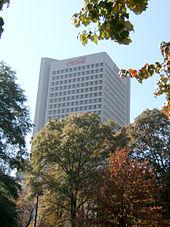
Atlanta began as a railroad town and logistics has remained a major component of the city aos economy to this day. Atlanta is an important rail junction and contains major classification yards for Norfolk Southern and CSX. Since its construction in the 1950s, Hartsfield-Jackson Atlanta International Airport has served as a key engine of Atlanta aos economic growth.[104] Delta Air Lines, the city's largest employer and the metro area aos third largest, operates the world aos largest airline hub at Hartsfield-Jackson Atlanta International Airport and has helped make Hartsfield-Jackson the world's busiest airport, both in terms of passenger traffic and aircraft operations.[105] Partly due to the airport, Atlanta has become a hub for diplomatic missions; as of 2012, the city contains 25 general consulates, the seventh-highest concentration of diplomatic missions in the United States.[106]
Media is also an important aspect of Atlanta aos economy. The city is a major cable television programming center. Ted Turner established the headquarters of both the Cable News Network (CNN) and the Turner Broadcasting System (TBS) in Atlanta. Cox Enterprises, the country aos third-largest cable television service and the publisher of over a dozen major American newspapers,[107] is headquartered in the city.[108][109][110] NBC Universal aos The Weather Channel is also headquartered in Atlanta.
Largely due to a state-wide tax incentive enacted in 2005, the Georgia Entertainment Industry Investment Act, which awards qualified productions a transferable income tax credit of 20% of all in-state costs for film and television investments of $500,000 or more,[111] Atlanta has become a center for film and television production. Film and television production facilities in Atlanta include Turner Studios, Tyler Perry Studios, Williams Street Productions, and the EUE/Screen Gems soundstages. Film and television production injected $1 billion into Georgia aos economy in 2010, with Atlanta garnering most of the projects.[112][113] Atlanta has gained recognition as a center of production of horror and zombie-related productions,[114] with ad adAtlanta ao ao magazine dubbing the city the "Zombie Capital of the World".[115][116]

Compared to its peer cities, Atlanta aos economy has been disproportionately affected by the 2008 financial crisis and the subsequent recession. The city aos economic problems are displayed in its elevated unemployment rate, declining real income levels, and depressed housing market.[117][118][119] From 2010-2011, Atlanta saw a 0.9% contraction in employment and a meager 0.4% rise in income. As of 2012, the unemployment rate in Atlanta was over 9%, higher the national average of 8.2%.[120] These dismal statistics have garnered Atlanta recognition as one of the world aos worst economic performers, with the city aos economy earning a ranking of 189 among 200 global cities, down from a ranking of 89 during the 1990s, when the city realized 1.6% income growth and 2.6% employment growth.[121] However, even when the 2008-2009 period is excluded, the 2001-2007 period is still one of the worst on record for Atlanta: the city never recovered the jobs it lost during the Early 2000s recession, and per capita income declined nearly 5% from 2000 to 2006, the largest decline among major U.S. cities. Thus, Atlanta aos current economic crisis was only worsened, and not caused, by the Recession.[122][123] Adding to the city aos employment and income woes is the spectacular collapse of its housing market. Atlanta home prices fell by 2.1% in January 2012, reaching levels not seen since 1996, a decline that measured among the worst in the country. Compared with a year earlier, the average home price in Atlanta fell 17.3% in February 2012, the largest annual drop in the history of the index for any city. Atlanta home values average $85,000 as of January 2012, second-worst among major metropolitan areas, coming in just behind Detroit.[124][125] This unprecedented collapse in home prices has led some economists to deem Atlanta the worst housing market in the country.[126]
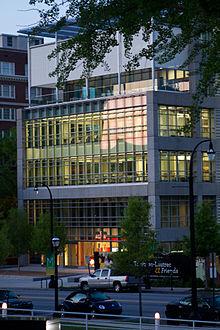
Atlanta, while very much in the South, has a culture that is no longer strictly Southern. This is because in addition to a large population of migrants from other parts of the U.S., many recent immigrants to the U.S. have chosen to make the city their home, making Atlanta one of the most multi-cultural in the nation.[127] Thus, although traditional Southern culture is part of Atlanta aos cultural fabric, it is mostly the backdrop to one of the nation aos leading international cities. This unique cultural combination reveals itself at the High Museum of Art, the bohemian shops of Little Five Points, and the multi-cultural dining choices found along Buford Highway.[128]
Atlanta is one of few United States cities with permanent, professional, resident companies in all major performing arts disciplines: opera (Atlanta Opera), ballet (Atlanta Ballet), music (Atlanta Symphony Orchestra), and theater (the Alliance Theatre). Atlanta also attracts many touring Broadway acts, concerts, shows, and exhibitions catering to a variety of interests. Atlanta aos performing arts district is concentrated in Midtown Atlanta at the Woodruff Arts Center, which is home to the Atlanta Symphony Orchestra and the Alliance Theatre. The city also frequently hosts touring Broadway acts, especially at The Fox Theatre, a historic landmark that is among the highest grossing theatres in of its size.[129]
As a national center for the arts,[130] Atlanta is home to significant art museums and institutions. The renowned High Museum of Art is arguably the South aos leading art museum and among the most-visited art museums in the world.[131] The Museum of Design Atlanta (MODA), a design museum, is the only such museum in the Southeast.[132] Contemporary art museums include the Atlanta Contemporary Art Center and the Museum of Contemporary Art of Georgia. Institutions of higher education also contribute to Atlanta aos art scene, with the Savannah College of Art and Design aos Atlanta campus providing the city aos arts community with a steady stream of curators, and Emory University aos Michael C. Carlos Museum containing the largest collection of ancient art in the Southeast.[133]
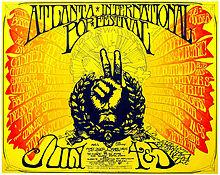
Atlanta has played a major or contributing role in the development of various genres of American music at different points in the city's history. Beginning as early as the 1920s, Atlanta emerged as a center for country music, which was brought to the city by migrants from Appalachia.[134] During the countercultural 1960s, Atlanta hosted the Atlanta International Pop Festival, with the 1969 festival taking place more than a month before Woodstock and featuring many of the same bands. The city was also a center for Southern rock during its 1970s heyday: the Allman Brothers Band's hit instrumental "Hot 'Lanta" is an ode to the city, while Lynyrd Skynyrd's famous live rendition of "Free Bird" was recorded at the Fox Theatre in 1976, with lead singer Ronnie Van Zant directing the band to "play it pretty for Atlanta."[135] During the 1980s, Atlanta had an active Punk rock scene that was centered around two of the city aos music venues, 688 Club and the Metroplex, and Atlanta famously played host to the Sex Pistols first U.S. show, which was performed at the Great Southeastern Music Hall.[136] The 1990s saw the birth of Atlanta hip hop, a sub-genre that gained relevance following the success of home-grown duo OutKast; however, it was not until the 2000s that Atlanta moved "from the margins to becoming hip-hop aos center of gravity, part of a larger shift in hip-hop innovation to the South."[137] Also in the 2000s, Atlanta was recognized by the Brooklyn-based Vice magazine for its impressive yet under-appreciated Indie rock scene, which revolves around the EARL in East Atlanta Village.[138][139]
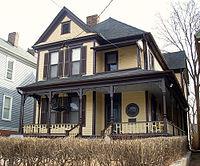
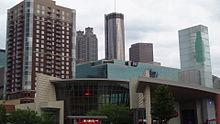
As of 2010, Atlanta is the seventh-most visited city in the United States, with over 35 million visitors per year.[140] Although the most popular attraction among visitors to Atlanta is the Georgia Aquarium,[141] the world aos largest indoor aquarium,[142] Atlanta aos tourism industry mostly driven by the city aos history museums and outdoor attractions. Atlanta contains a notable amount of historical museums and sites, including the Martin Luther King, Jr. National Historic Site, which includes the preserved boyhood home of Dr. Martin Luther King, Jr., as well as his final resting place; the Atlanta Cyclorama & Civil War Museum, a civil war museum that houses a massive painting and diorama in-the-round, with a rotating central audience platform, depicting the Battle of Atlanta in the Civil War; the World of Coca-Cola, featuring the history of the world famous soft drink brand and its well-known advertising; the Carter Center and Presidential Library, housing U.S. President Jimmy Carter aos papers and other material relating to the Carter administration and the Carter family aos life; and the Margaret Mitchell House and Museum, site of the writing of the best-selling novel Gone With the Wind.
Atlanta also contains various outdoor attractions.[143] The Atlanta Botanical Garden, adjacent to Piedmont Park, is home to the 600-foot-long (180 m) Kendeda Canopy Walk, a skywalk that allows visitors to tour one of the city aos last remaining urban forests from 40-foot-high (12 m). The Canopy Walk is considered the only canopy-level pathway of its kind in the United States. Zoo Atlanta, located in Grant Park, accommodates over 1,300 animals representing more than 220 species. Home to the nation aos largest collections of gorillas and orangutans, the Zoo is also one of only four zoos in the U.S. to house giant pandas.[144] Festivals showcasing arts and crafts, film, and music, including the Atlanta Dogwood Festival, the Atlanta Film Festival, and Music Midtown, respectively, are also popular with tourists.[145]

Tourists are also drawn to the city aos culinary scene, which comprises a mix of urban establishments garnering national attention, ethnic restaurants serving cuisine from every corner of the world, and traditional eateries specializing in Southern dining. Since the turn of the 21st century, Atlanta has emerged as a sophisticated restaurant town.[146] Many restaurants opened in the city aos gentrifying neighborhoods have received praise at the national level, including Bocado, Bacchanalia, and Miller Union in West Midtown, Empire State South in Midtown, and Two Urban Licks and Rathbun aos on the east side.[147][148][149] In 2011, the ad adNew York Times ao ao characterized Empire State South and Miller Union as reflecting "a new kind of sophisticated Southern sensibility centered on the farm but experienced in the city."[150] Visitors seeking to sample international Atlanta are directed to Buford Highway, the city aos international corridor. There, the million-plus immigrants that make Atlanta home have established various authentic ethnic restaurants representing virtually every nationality on the globe.[151] For traditional Southern fare, one of the city aos most famous establishments is The Varsity, a long-lived fast food chain and the world aos largest drive-in restaurant.[152] Mary Mac's Tea Room and Paschal's are more formal destinations for Southern food.
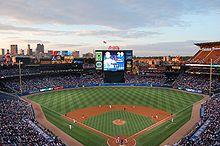
Atlanta is home to professional franchises for three major team sports: the Atlanta Braves of Major League Baseball, the Atlanta Hawks of the National Basketball Association, and the Atlanta Falcons of the National Football League. The Braves are the oldest continually operating professional sports franchise in America. The Braves won the World Series in 1995, and had an unprecedented run of 14 straight divisional championships from 1991 to 2005.[153] The Atlanta Falcons have played in Atlanta since 1966. The Falcons have won the division title four times (1980, 1998, 2004, 2010) and the conference championship once, when they finished as the runner-up to the Denver Broncos in Super Bowl XXXIII in 1999.[154] The Atlanta Hawks began in 1946 as the Tri-Cities Blackhawks, playing in Moline, Illinois. The team moved to Atlanta in 1968, and they currently play their games in Philips Arena.[155] The Atlanta Dream is the city aos Women aos National Basketball Association franchise.[156]
Atlanta has also had its own professional ice hockey and soccer franchises. The National Hockey League (NHL) has had two Atlanta franchises: the Atlanta Flames began play in 1972 before moving to Calgary in 1980, while the Atlanta Thrashers began play in 1999 before moving to Winnipeg in 2011. The Atlanta Chiefs was the city aos professional soccer team from 1967 to 1972, and the team won a national championship in 1968.
Atlanta has been the host city for various international, professional and collegiate sporting events. Most famously, Atlanta hosted the Centennial 1996 Summer Olympics. Atlanta has also hosted Super Bowl XXVIII in 1994 and Super Bowl XXXIV in 2000. In professional golf, The Tour Championship, the final PGA Tour event of the season, is played annually at East Lake Golf Club. In 2001 and 2011, Atlanta hosted the PGA Championship, one of the four major championships in men aos professional golf, at the Atlanta Athletic Club. In 2011, Atlanta hosted professional wrestling aos annual WrestleMania. The city has hosted the NCAA Final Four Men aos Basketball Championship four times, most recently in 2007. In college football, Atlanta hosts the Chick-fil-A College Kickoff, the SEC Championship Game, and the Chick-fil-A Bowl.[157]
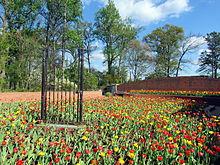
Atlanta aos 343 parks, nature preserves, and gardens cover 3,622 acres (14.66 km2),[158] which amounts to only 5.6% of the city aos total acreage, compared the national average of just over 10%.[159][160] However, 63% of Atlantans live within a 10-minute walk of a park, placing the city just above the national average of 62%.[159][160] Piedmont Park, located in Midtown is Atlanta aos iconic green space. The park, which underwent a major renovation and expansion in 2010, attracts visitors from across the region and hosts cultural events throughout the year. Other notable city parks include Centennial Olympic Park, a legacy of the 1996 Summer Olympics that forms the centerpiece of the city aos tourist district; Woodruff Park, which anchors the central business district and the campus of Georgia State University; Grant Park, home to both Zoo Atlanta and the Atlanta Cyclorama & Civil War Museum; and Chastain Park, which houses an amphitheater used for live music concerts. The Chattahoochee River National Recreation Area, located in the northwestern corner of the city, preserves a 48-mile (77 km) stretch of the river for public recreation opportunities. The Atlanta Botanical Garden, adjacent to Piedmont Park, contains formal gardens, including a Japanese garden and a rose garden, woodland areas, and a conservatory that includes indoor exhibits of plants from tropical rainforests and deserts. The BeltLine, a former rail corridor that forms a 22 miles (35 km) loop around Atlanta aos core, will eventually be transformed into a series of parks, connected by a multi-use trail, increasing Atlanta aos park space by 40%.[161]
Atlanta offers resources and opportunities for amateur and participatory sports and recreation. Jogging a particularly popular local sport. The Peachtree Road Race, the world aos largest 10 km race, is held annually on Independence Day.[162] The Georgia Marathon, which begins and ends at Centennial Olympic Park, routes through the city aos historic east side neighborhoods.[163] Golf and tennis are also popular in Atlanta, and the city contains six public golf courses and 182 tennis courts. Facilities located along the Chattahoochee River cater to watersports enthusiasts, providing the opportunity for kayaking, canoeing, fishing, boating, or tubing. The city's only skate park, a 15,000 square feet (1,400 m2) facility that offers bowls, curbs, and smooth-rolling concrete mounds, is located at Historic Fourth Ward Park.[164]
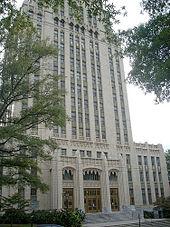
Atlanta is governed by a mayor and the Atlanta City Council. The city council consists of 15 representatives aeone from each of the city aos 12 districts and three at-large positions. The mayor may veto a bill passed by the council, but the council can override the veto with a two-thirds majority.[165] The mayor of Atlanta is Kasim Reed, a Democrat elected on a nonpartisan ballot whose first term in office will expire at the end of 2013. Every mayor elected since 1973 has been black.[166] In 2001, Shirley Franklin became the first woman to be elected Mayor of Atlanta, and the first African-American woman to serve as mayor of a major southern city.[167] Atlanta city politics suffered from a notorious reputation for corruption during the 1990s administration of Bill Campbell, who was convicted by a federal jury in 2006 on three counts of tax evasion in connection with gambling income he received while Mayor during trips he took with city contractors.[168]
As the state capital, Atlanta is the site of most of Georgia aos state government. The Georgia State Capitol building, located downtown, houses the offices of the governor, lieutenant governor and secretary of state, as well as the General Assembly. The Governor's Mansion is located in a residential section of Buckhead. Atlanta serves as the regional hub for many arms of the federal bureaucracy, including the Federal Reserve Bank of Atlanta and the Centers for Disease Control and Prevention.[169][170] Atlanta also plays an important role in federal judiciary system, containing the United States Court of Appeals for the Eleventh Circuit and of the United States District Court for the Northern District of Georgia.
Historically, Atlanta has been a stronghold for the Democratic Party. Although municipal elections are officially nonpartisan, nearly all of the city aos elected officials are registered Democrats. The city is split between 14 state house districts and four state senate districts, all held by Democrats. At the federal level, Atlanta is split between two congressional districts. The northern three-fourths of the city is located in the 5th district, represented by Democrat John Lewis. The southern fourth is in the 13th district, represented by Democrat David Scott.
The city is served by the Atlanta Police Department, which numbers 1,700 officers and oversaw a 40% decrease in the city's crime rate between 2001 and 2009. Specifically, homicide decreased by 57%, rape by 72%, and violent crime overall by 55%. Crime is down across the country, but Atlanta aos improvement has occurred at more than twice the national rate.[171] Forbes ranked Atlanta as the sixth most dangerous city in the United States.[172]
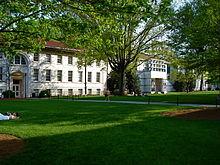
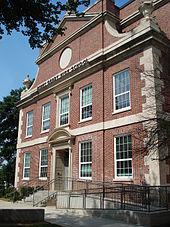
Due to the more than 30 colleges and universities located in the city, Atlanta is considered a center for higher education.[173] Among the most prominent public universities in Atlanta is the Georgia Institute of Technology, a research university located in Midtown that has been consistently ranked among the nation aos top ten public universities for its degree programs in engineering, computing, management, the sciences, architecture, and liberal arts. Georgia State University, a public research university located in Downtown Atlanta, is the second largest of the 35 colleges and universities in the University System of Georgia and a major contributor to the revitalization of the city aos central business district. Atlanta is also home to nationally renowned private colleges and universities, most notably Emory University, a leading liberal arts and research institution that ranks among the top 20 schools in the United States and operates Emory Healthcare, the largest health care system in Georgia.[174] Also located in the city is the Atlanta University Center, the largest contiguous consortium of historically black colleges, comprising Clark Atlanta University, Morehouse College, Spelman College, and Interdenominational Theological Center. Atlanta also contains a campus of the Savannah College of Art and Design, a private art and design university that has proven to be a major factor in the recent growth of Atlanta aos visual art community.
Atlanta Public Schools enrolls 55,000 students in 106 schools, some of which are operated as charter schools.[175] The district has been plagued by a widely publicized cheating scandal exposed in 2009. Atlanta is also served by various private schools, as well as parochial Roman Catholic schools operated by the Archdiocese of Atlanta.
The primary network-affiliated television stations in Atlanta are WXIA-TV (NBC), WGCL-TV (CBS), WSB-TV (ABC), and WAGA-TV (Fox). The Atlanta metropolitan area is served by two public television stations and one public radio station. WGTV is the flagship station of the statewide Georgia Public Television network and is a PBS member station, while WPBA is owned by Atlanta Public Schools. Georgia Public Radio is listener-funded and comprises one NPR member station, WABE, a classical music station operated by Atlanta Public Schools.
Atlanta is served by the Atlanta Journal-Constitution, its only major daily newspaper with wide distribution. The Atlanta Journal-Constitution is the result of a 1950 merger between The Atlanta Journal and The Atlanta Constitution, with staff consolidation occurring in 1982 and separate publication of the morning Constitution and afternoon Journal ceasing in 2001.[176] Alternative weekly newspapers include Creative Loafing, which has a weekly print circulation of 80,000. Atlanta magazine is an award-winning, monthly general-interest magazine based in and covering Atlanta.
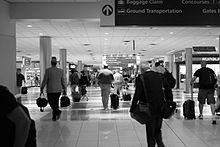

Atlanta's transportation infrastructure comprises a complex network that includes a heavy rail subway system, multiple interstate highways, the world's busiest airport, and over 45 miles of bike paths.
The Metropolitan Atlanta Rapid Transit Authority (MARTA) provides public transportation in the form of buses, light rail, and heavy rail. Notwithstanding heavy automotive usage in Atlanta, the city aos subway system is the eighth busiest in the country.[177] MARTA rail lines connect many key destinations, such as the airport, Downtown, Midtown, Buckhead, and Perimeter Center. However, significant destinations, such as Emory University, Cumberland and Turner Field, remain unserved. As a result, a 2012 Brookings Institute study placed Atlanta 87th of 100 metro areas for transit accessibility.[178] Amtrak, the national rail passenger system, provides service to Atlanta via the ad adCrescent train ao ao (New York aeNew Orleans), which stops at Peachtree Station. Of the five Georgia stations served by Amtrak, Atlanta was the busiest in 2011, boarding or detraining an average of 315 passengers daily.[179]
With a comprehensive network of freeways that radiate out from the city, automobiles are the dominant mode of transportation in the region.[180] Three major interstate highways converge in Atlanta: I-20 (east-west), I-75 (northwest-southeast), and I-85 (northeast-southwest). The latter two combine in the middle of the city to form the Downtown Connector (I-75/85), which carries more than 340,000 vehicles per day and is one of the ten most congested segments of interstate highway in the United States.[181] Atlanta is mostly encircled by Interstate 285, a beltway locally known as "the Perimeter" that has come to mark the boundary between auInside the Perimeter au (ITP), the city and close-in suburbs, and auOutside the Perimeter au (OTP), the outer suburbs and exurbs. The heavy reliance on automobiles for transportation in Atlanta has resulted in traffic, commute, and air pollution rates that rank among the worst in the country.[182][183][184]
Hartsfield-Jackson Atlanta International Airport, the world's busiest airport as measured by passenger traffic and aircraft traffic,[185] offers air service to over 150 U.S. destinations and more than 80 international destinations in 52 countries, with over 2,700 arrivals and departures daily.[186] Delta Air Lines maintains its largest hubs at the airport.[187] Situated 10 miles (16 km) south of downtown, the airport covers most of the land inside a wedge formed by Interstate 75, Interstate 85, and Interstate 285.
Cycling is a growing mode of transportation in Atlanta, more than doubling since 2009, when it comprised 1.1% of all commutes (up from 0.3% in 2000).[188][189] Although Atlanta aos lack of bike lanes may deter many residents from cycling,[188][190] the city aos transportation plan calls for the construction of 226 miles of bike lanes by 2020, with the BeltLine helping to achieve this goal.[191]
For a sprawling city with the nation's ninth-largest metro area, Atlanta is surprisingly lush with trees aemagnolias, dogwoods, Southern pines, and magnificent oaks.
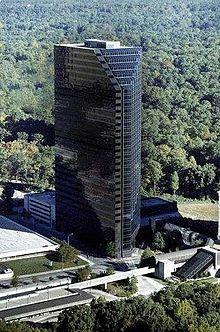
Atlanta has a reputation as the "city in a forest" due to an abundance of trees that is unique among major cities.[193][194][195][196][197] The city aos main street is named after a tree, and beyond the Downtown, Midtown, and Buckhead business districts, the skyline gives way to a dense canopy of woods that spreads into the suburbs. The city is home to the Atlanta Dogwood Festival, an annual arts and crafts festival held one weekend during early April, when the native dogwoods are in bloom. However, the nickname is also factually accurate, as the city aos tree coverage percentage is at 36%, the highest out of all major American cities, and above the national average of 27%.[198] Atlanta aos tree coverage does not go unnoticed aeit was the main reason cited by ad adNational Geographic ao ao in naming Atlanta a "Place of a Lifetime."[199][200]
The city aos lush tree canopy, which filters out pollutants and cools sidewalks and buildings, has increasingly been under assault from man and nature due to heavy rains, drought, aged forests, new pests, and urban construction. A 2001 study found that Atlanta aos heavy tree cover declined from 48% in 1974 to 38% in 1996.[201] However, the problem is being addressed by community organizations and city government: Trees Atlanta, a non-profit organization founded in 1985, has planted and distributed over 75,000 shade trees in the city,[202] while Atlanta aos government has awarded $130,000 in grants to neighborhood groups to plant trees.[194]
Atlanta has 21 sister cities, as designated by Sister Cities International, Inc. (SCI):[203]


Word Count: 8351





